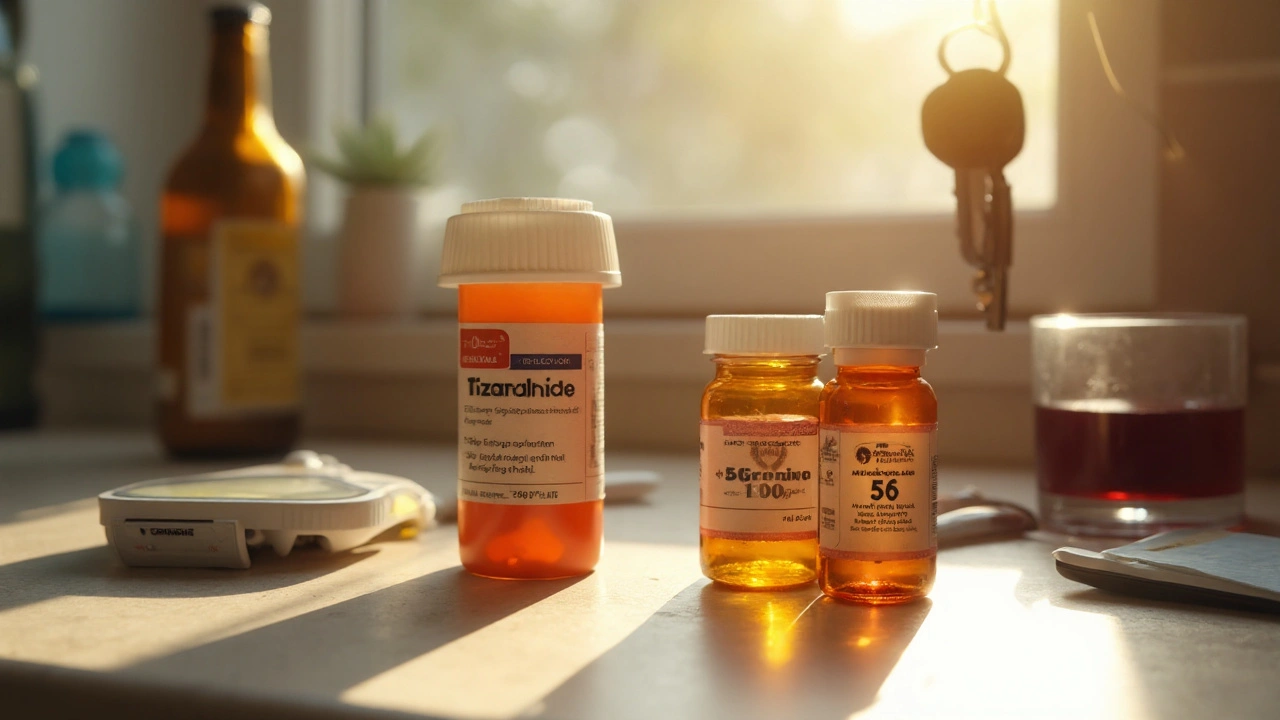Phantom limb pain can hijack your day out of nowhere-burning, stabbing, buzzing in a limb that isn’t there. If you’ve tried the usual nerve pain meds and you’re still hurting (or sleepy, foggy, or both), you might be wondering whether Tizanidine could calm things down. It’s not a magic switch, and it’s off-label for phantom limb pain, but it can help the right person-especially if muscle spasms and lousy sleep are part of the story. Here’s what it can and can’t do, how to start it safely, and when to skip it.
TL;DR
- Off-label for phantom limb pain; evidence is limited. It may help with spasms, sleep, and overall pain intensity in a subset of patients.
- Best as an add-on when first-line neuropathic meds (gabapentin/pregabalin, amitriptyline, duloxetine) only partly help or aren’t tolerated.
- Start low (2 mg at bedtime), go slow, and monitor blood pressure and liver enzymes. Avoid ciprofloxacin and fluvoxamine.
- Expect gradual effects over 1-2 weeks; taper if stopping to avoid rebound hypertension and racing heartbeat.
- Pair with mirror therapy, desensitization, prosthetic training, and good stump care for better results.
Where Tizanidine Fits in Phantom Limb Pain: What It Helps, What It Doesn’t, and What the Evidence Says
Phantom limb pain isn’t one thing. There’s the “phantom” pain in the missing limb, plus residual limb (stump) pain, and sometimes cramping or clenching sensations. The nervous system plays the lead role: spinal cord circuits get hyperexcitable, the brain reshapes its map, and the whole system amplifies signals that shouldn’t hurt. Tizanidine is an alpha-2 adrenergic agonist. In plain terms, it dials down the chatter in the spinal cord and reduces exaggerated reflexes. That’s why it’s FDA-approved for spasticity. For phantom limb pain, the hope is it calms overactive pathways and eases spasm-driven pain and sleep disruption.
What people actually notice when it helps: fewer nighttime jolts, less clenching or cramping in the residual limb, easier time falling asleep, and a modest drop in pain intensity. Think “smoother baseline” rather than “pain gone.” It pairs well with a nerve pain med (like gabapentin or duloxetine) and non-drug work like mirror therapy, graded motor imagery, and steady prosthetic use once fitted.
What it won’t do: it won’t remake the brain’s pain map on its own; it won’t fix socket fit issues; and it won’t outshine a well-run rehab plan. If your pain is purely electric/burning with minimal spasm, a gabapentinoid or an antidepressant class pain med often beats tizanidine as the first move.
How strong is the evidence? As of 2025, high-quality studies of tizanidine for phantom limb pain are missing. We have case reports and small series where clinicians used it as an adjunct in mixed neuropathic pain or amputation populations and saw sleep and pain benefits in some patients. No large randomized trials for phantom limb pain specifically. Cochrane reviews on pharmacologic treatment of phantom limb pain highlight limited and mixed drug evidence across the board, with better data supporting mirror therapy and graded motor imagery than most pills. Bottom line: tizanidine is a reasonable add-on when spasm and sleep problems are in the mix, but it’s not a first-line, evidence-rich option.
Use this simple rule of thumb:
- Clear spasm/cramp component or residual limb “tightness” + sleep disruption → consider tizanidine as an adjunct.
- Pure neuropathic burn/shock pain with little spasm → start with gabapentin/pregabalin, duloxetine, or amitriptyline.
- Severe daytime sedation risk, very low blood pressure, active liver disease, or interacting meds → avoid tizanidine.
What outcomes should you aim for? Realistic wins look like 20-40% less pain intensity, fewer flare-ups at night, less clenching, and better sleep continuity within 1-3 weeks of dose finding. That kind of improvement often unlocks progress with rehab tasks that truly move the needle long-term (mirror therapy reps, desensitization work, wearing your prosthesis longer without flares).
| Topic | Practical takeaways for phantom limb pain |
|---|---|
| Mechanism | Alpha-2 agonist dampening spinal cord excitability; reduces exaggerated reflexes and spasm. Can blunt central sensitization signals. |
| Onset | Sleep and spasm may improve within days; pain relief is gradual (1-2 weeks) as you reach a steady, tolerated dose. |
| Best suited for | Spasm/clenching of residual limb, nighttime jolts, sleep fragmentation; partial response to first-line neuropathic meds. |
| Evidence level (PLP) | Off-label; small-scale reports/clinical experience; no large RCTs specific to phantom limb pain as of 2025. |
| Common limits | Sleepiness, dizziness, low blood pressure, dry mouth; short half-life means multiple daily doses for sustained effect. |
| Key interactions | Ciprofloxacin and fluvoxamine (avoid); other CYP1A2 inhibitors raise levels; additive sedation with opioids/benzos/alcohol. |
| Monitoring | Blood pressure/heart rate at baseline and during titration; liver enzymes at baseline and after dose increases. |
Credible sources note these points: the FDA label backs its use for spasticity, not phantom limb pain; reviews in pain and rehabilitation journals through 2024-2025 continue to place non-drug therapy at the core of phantom limb pain care; and neuropathic pain guidelines (AAN and similar) favor gabapentinoids and certain antidepressants first for nerve pain-not tizanidine-while acknowledging it can help when spasm drives symptoms.

How to Start, Dose, and Combine It: A Step-by-Step, Low-Risk Plan
Before you start, line up the basics. This is where people either set themselves up for a smooth run-or get knocked back by side effects.
Pre-start checklist
- List all meds and supplements. Show them to your clinician. Deal-breakers include ciprofloxacin and fluvoxamine. Big caution with other sedatives, strong CYP1A2 inhibitors (zileuton, cimetidine), some hormonal contraceptives, and certain antiarrhythmics.
- Measure sitting and standing blood pressure and heart rate. If your pressure runs very low, talk through safer options first.
- Get baseline liver enzymes if you’ll be on it more than a short trial.
- Agree on goals: fewer night jolts, less clenching, better sleep, and a measurable pain drop.
Starting dose and titration
- Night 1: 2 mg at bedtime. Stick with the same formulation (tablet vs capsule) and timing each day. Food changes absorption-be consistent with meals.
- After 3-4 nights: If drowsiness is manageable and blood pressure holds, add 2 mg earlier in the evening (or mid-day if daytime spasms are a problem).
- Increase by 2 mg every 3-7 days, adding a morning or afternoon dose if needed, aiming for 6-12 mg/day split in 2-3 doses. Many people land between 4 and 16 mg/day for pain and spasm relief. Do not exceed 36 mg/day (that’s the absolute ceiling for spasticity, not a target for pain).
- For persistent nighttime spikes: shift more of the dose toward evening while keeping a small daytime dose to prevent rebound symptoms.
Practical timing tips
- Half-life is short. Expect 3-6 hours of effect per dose. For round-the-clock relief, split dosing works better than one big hit.
- If morning grogginess is bad, move the last dose earlier in the evening or trim the total by 2 mg and reassess in a week.
- If daytime lightheadedness hits, reduce or skip the morning dose and focus on evening coverage.
Combining with other treatments
- Gabapentin/pregabalin: Common and often helpful combo-different mechanisms. Watch for extra sleepiness, and adjust one med at a time.
- Duloxetine or amitriptyline: Also reasonable. Start low on both if combining. Dry mouth from amitriptyline plus tizanidine can be rough-sip water, sugar-free lozenges.
- Opioids and benzodiazepines: Use caution. Sedation stacks. If you’re on these, dose tizanidine carefully or consider alternatives.
- Non-drug therapies: Mirror therapy (daily), graded motor imagery, desensitization with varied textures, and steady prosthetic training-these are the bedrock. Tizanidine makes the work more doable by easing flares and sleep loss.
Special situations
- Liver issues: Prefer other options or keep doses low with close lab follow-up.
- Kidney issues: Clearance is reduced. Start at 2 mg nightly and titrate slower.
- Elderly or frail: Very slow titration. Prioritize fall risk prevention; monitor orthostatic blood pressure.
- Stopping: Taper by 2-4 mg every 3-7 days to avoid rebound high blood pressure, fast heart rate, and anxiety.
Formulation notes you’ll actually use
- Tablets and capsules are not interchangeable milligram-for-milligram when food varies. Pick one and keep your routine (with or without food) the same each day.
- Generic is usually fine. If you switch manufacturers and feel different effects, tell your pharmacist; consistency matters for a short-acting drug.

Safety, Red Flags, FAQs, and Real-World Troubleshooting
Side effects you might feel-and what to do
- Sleepiness or fogginess: Most common. Use the smallest effective dose, bias toward night dosing, and give your body a week to adapt before each increase.
- Dizziness or low blood pressure: Stand up slowly, drink water, and consider compression socks if you run low. If you faint or have near-faints, call your clinician and cut back.
- Dry mouth: Sugar-free lozenges, frequent sips, and good dental care help.
- Weakness: Usually dose-related. Trim by 2 mg and reassess in 3-4 days.
- Rare but serious: Liver injury (yellow eyes/skin, dark urine, right upper belly pain), hallucinations, bradycardia. Seek care immediately.
Drug interactions that matter
- Ciprofloxacin or fluvoxamine: Do not combine. They can spike tizanidine levels and cause dangerous drops in blood pressure.
- Other CYP1A2 inhibitors (zileuton, cimetidine, some antidepressants, certain oral contraceptives): May raise levels-use lower doses and monitor closely.
- Alcohol, opioids, benzodiazepines, sleep meds: Sedation stacks. A small change in one can feel big when combined.
- Other alpha-2 agonists (clonidine, guanfacine): Risk of excessive low blood pressure and slow heart rate.
- Antihypertensives: You may need to adjust your blood pressure regimen if you feel dizzy on standing.
Mini-FAQ
- Will it help my phantom limb pain? It can, especially if spasms and sleep problems are part of the picture. It’s not the most proven option but can be a useful add-on.
- How long until I notice a difference? Sleep and cramping may ease within days; pain relief usually creeps in over 1-2 weeks as you fine-tune the dose.
- Can I take it with gabapentin or duloxetine? Yes, often paired. Watch for extra sleepiness. Adjust one medication at a time so you can tell what’s doing what.
- Is it addictive? No. But you should taper off to avoid rebound symptoms.
- Can I drive? Not at first. See how you feel. If you’re drowsy or lightheaded, skip driving and heavy machinery.
- What labs do I need? Many clinicians check liver enzymes at baseline and again after a few weeks of dose changes, then periodically if you stay on it.
- Capsule or tablet-does it matter? Yes. Food changes how much gets absorbed. Pick one form and stick with a consistent food routine.
Red flags: stop and call your clinician if you have fainting, severe or persistent vomiting, yellowing of the skin or eyes, new confusion or hallucinations, or a sudden racing heartbeat after missing doses.
Quick decision aids
- If your pain spikes when you try to sleep, and your residual limb cramps or feels like it’s clenching-tizanidine is worth a careful trial.
- If you’re already sleeping fine but daytime shocks and burning dominate-prioritize a gabapentinoid or duloxetine first.
- If you need to stay sharp at work or drive early mornings-shift tizanidine to evening, keep daytime doses small or none.
- If your blood pressure is on the low side-ask about alternatives or micro-dosing with close monitoring.
Safety checklist before and during use
- Before: Review meds for interactions; check blood pressure sitting and standing; establish goals; plan follow-up in 2-3 weeks.
- Week 1-2: Track sleepiness, dizziness, and pain scores (0-10). Keep a brief daily log.
- Week 3-4: If no benefit at 6-8 mg/day and side effects are a pain, reconsider the plan. If some benefit, consider a cautious 2 mg bump.
- Any time you stop: Taper by small steps every few days, not cold turkey.
Pair it with the rehab work that changes the game
- Mirror therapy: Short, daily sessions beat rare long ones. Aim for consistency.
- Graded motor imagery: Mental rehearsal and laterality training help rewire the brain’s map.
- Desensitization: Touch, vibration, temperature changes on the residual limb to calm overreactive nerves.
- Prosthetic fit and training: A snug, comfortable fit prevents mechanical triggers that meds can’t fix.
Troubleshooting common scenarios
- Too sleepy on 4 mg at night, but pain is better: Try 3-4 nights at 2 mg, then 3 mg (use scored tablets if available), or move the dose earlier. Keep it simple and steady.
- Evening pain relief fades by midnight: Split the evening dose (e.g., 2 mg at dinner, 2 mg at bedtime) rather than one larger chunk that spikes side effects.
- Blood pressure dips when standing: Hydrate, rise slowly, consider light compression socks, and reduce or delay the morning dose.
- Starting mirror therapy triggers pain flares: Pre-medicate with your evening dose 30-60 minutes before the session, and shorten session length to tolerance.
- No benefit after 2-3 weeks at 8-12 mg/day: Time to pivot-optimize first-line neuropathic meds, consider a pain rehab referral, or explore options like peripheral nerve stimulation in refractory cases.
What the pros watch for
- Objective gains matter: Better sleep duration, more steps with the prosthesis, fewer pain spikes. Not just a lower pain score.
- Interacting antibiotics: If you’re prescribed ciprofloxacin for a UTI, bring up tizanidine before you take the first dose. There are other antibiotic choices.
- Rebound risk: Missing several doses then restarting at the prior level can feel rough. If you paused for a few days, resume at a lower dose.
What to expect from your clinician
- A clear off-label discussion: why it’s being tried, what success looks like, and what would make you stop.
- A simple titration calendar and a date to check in (often 2-4 weeks after starting).
- Baseline and follow-up blood pressure checks, plus liver enzymes for longer use.
Why a layered plan wins
Phantom limb pain usually eases when you chip away from several angles-brain retraining, mechanical fit, sleep, and nerve signals. Tizanidine can quiet the nervous system enough to let that other work stick. If you pick patients carefully, dose slowly, and respect the drug’s short half-life and interaction profile, you give it a fair shot without getting burned by side effects. If it doesn’t help, you’ll know within a few weeks and can move on without losing time.
Key takeaways for quick decisions
- Think add-on, not cure-all; aim to improve sleep and reduce spasm-linked pain.
- Start 2 mg at bedtime; increase by 2 mg every 3-7 days; split doses for steady coverage.
- Watch for drowsiness and low blood pressure; get liver labs if you’ll be on it beyond a brief trial.
- Avoid major interactions and always taper if you stop.
- Keep non-drug therapy front and center-it’s where the lasting change happens.
Sources behind these recommendations include the FDA prescribing information for tizanidine (spasticity), systematic reviews on phantom limb pain treatments through 2024-2025 in rehabilitation and pain journals, and neuropathic pain guidelines from major neurology associations that prioritize gabapentinoids and certain antidepressants ahead of muscle relaxants for primary nerve pain. Those documents converge on a simple idea: use targeted meds to make functional rehab possible, and keep safety guardrails tight.





Shanice Alethia
September 6, 2025 AT 01:41Oh please. Tizanidine? You’re telling people to take a muscle relaxant for phantom pain like it’s some kind of miracle cure? I’ve seen this exact script play out in 3 different amputee support groups-every time someone tries it, they end up passed out on the floor or in the ER because their BP dropped like a rock. This isn’t medicine, it’s a gamble with your nervous system. And don’t even get me started on the ‘mirror therapy’ fairy tale. You think waving a mirror in front of your stump is going to fix your brain’s hallucinations? That’s like trying to fix a corrupted hard drive by yelling at it.
Meanwhile, the real solution? Neurostimulators. Implanted electrodes. The tech exists. It’s FDA-approved. But nooooo, let’s keep pushing cheap, sedating, liver-toxic pills because Big Pharma doesn’t make enough profit off devices. Wake up, people.
This post is dangerous. And it’s not even original-it’s just a repackaged pharma pamphlet with a fancy table.
Eben Neppie
September 6, 2025 AT 08:42Shanice, you’re not wrong about the risks-but you’re also ignoring the fact that 40% of amputees don’t qualify for neurostimulators. Insurance denies them. Surgeons won’t touch them unless the pain is ‘debilitating.’ And for people stuck with chronic, low-grade phantom pain that keeps them up at night? Tizanidine is the only thing that lets them sleep without opioids.
Let’s not confuse ‘not ideal’ with ‘useless.’ I’ve seen patients go from 8/10 pain to 5/10 with tizanidine + gabapentin + nightly stretching. That’s not a miracle. But it’s enough to get them out of bed, put on their prosthesis, and walk to the mailbox. That’s a win. You don’t need a cure-you need function.
And mirror therapy? It’s not magic. It’s neuroplasticity. Your brain’s map of your body is outdated. Mirror therapy is like updating a corrupted OS. It’s slow. It’s boring. But it works. And yes, it’s cheaper than surgery.
Stop attacking the tool because the system is broken.
Sam Tyler
September 7, 2025 AT 04:33Thank you, Eben, for grounding this in reality. There’s a real danger in treating this like a binary choice: either you get a $50,000 implant or you suffer. The truth is, most people with phantom limb pain are navigating a patchwork of imperfect tools-and tizanidine is one of them. It’s not the first-line drug for a reason, but it’s not the villain either.
I’ve worked with veterans who’ve tried everything: ketamine infusions, spinal cord stimulators, acupuncture, even TMS. For some, tizanidine was the one thing that didn’t make them feel like a zombie, didn’t cost a fortune, and didn’t require a 6-month waiting list. It’s not glamorous. It’s not sexy. But it’s real.
Also, the point about liver enzymes and ciprofloxacin? Critical. Too many people assume ‘over-the-counter’ means ‘safe.’ This drug has a narrow therapeutic window. But so does Tylenol. That doesn’t mean we ban it. We educate.
Let’s stop pretending one-size-fits-all solutions exist. This post gives practical, cautious guidance. That’s rare. Let’s not tear it down because it doesn’t offer a sci-fi solution.
And yes-mirror therapy works. I’ve watched a 72-year-old woman with 18 years of phantom pain finally sleep through the night after 3 weeks of daily 10-minute sessions. She cried. Not because the pain vanished-but because she could finally rest.
Milind Caspar
September 7, 2025 AT 08:15Sam Tyler, your sentimentality is touching-but it’s also dangerously naive. You speak of ‘veterans’ and ‘72-year-old women’ as if their suffering is a moral argument for pharmacological convenience. But what about the 23-year-old amputee who takes tizanidine because he’s too scared to ask for help with PTSD? He’s not seeking pain relief-he’s seeking numbness. And now he’s dependent on a drug that causes rebound hypertension, liver toxicity, and sedation that makes him miss work.
This isn’t harm reduction. This is enabling. The medical establishment has spent decades pushing pills as the default solution because it’s easier than addressing trauma, systemic neglect, and lack of access to physical rehab. Tizanidine isn’t a tool-it’s a Band-Aid on a severed artery.
And don’t give me that ‘mirror therapy works’ nonsense. It’s a placebo with a fancy name. The brain doesn’t ‘re-map’ from watching a mirror. It’s confirmation bias wrapped in neuroscience jargon. If you want real neuroplasticity, try transcranial magnetic stimulation-or better yet, stop blaming the patient for not doing enough when their healthcare system abandoned them.
This post is a textbook example of medical gaslighting. You’re telling people to ‘try it’ while ignoring the real systemic failures. Shame on you.
Lugene Blair
September 7, 2025 AT 13:20Milind, I hear you. And I’ve seen the system fail. I’ve been the one who couldn’t get a therapist for six months after my amputation. I’ve cried in waiting rooms because my insurance said ‘phantom pain isn’t medically necessary.’
But here’s what I learned: when you’re in pain, you don’t get to wait for the perfect solution. You take what helps you breathe. Tizanidine didn’t fix my trauma. But it let me get out of bed long enough to find a therapist. It let me hold my daughter without screaming. That matters.
Yes, the system is broken. But we don’t fix it by refusing to use tools that work-even if they’re imperfect. We fix it by using them, talking about them, and demanding better access to better options.
Stop calling people naive for trying to survive. We’re not asking for miracles. We’re asking for a chance.
KC Liu
September 8, 2025 AT 05:02Oh, so now we’re supposed to believe that tizanidine is ‘safe’ because a woman cried after mirror therapy? Please. This is the same logic that got us hooked on opioids. ‘It helped someone, so it’s okay.’
Let me ask you this: who funded this ‘2025 Guide’? Any pharma company listed? Any conflict of interest disclosed? No? Then why does every paragraph sound like a rep’s talking points?
And mirror therapy? I’ve looked at the studies. The effect size is tiny. Most trials are underpowered. The only reason it’s popular is because it’s cheap and non-invasive-so hospitals can say they’re ‘doing something’ without spending a dime.
Meanwhile, the real breakthroughs? Ketamine nasal sprays. Psychedelic-assisted therapy. Cannabinoid analogs. But no-let’s keep pushing a muscle relaxant that’s been around since 1978 because it’s easy to prescribe.
This isn’t medicine. It’s institutional inertia dressed up as compassion.
Rose Macaulay
September 8, 2025 AT 11:06I just lost my leg last year. I tried gabapentin. Made me feel like a zombie. Amitriptyline gave me dry mouth so bad I couldn’t swallow. Then I tried 2mg of tizanidine at night. Didn’t knock me out. Just… quieted the screaming. I slept for 5 hours straight for the first time in months.
I don’t care if it’s off-label. I don’t care if it’s ‘not proven.’ It gave me back my nights. And that’s enough.
Hudson Owen
September 9, 2025 AT 07:59Rose, thank you for sharing that. Your experience is precisely why this guide matters. Not because it’s a perfect protocol-but because it gives voice to the quiet, incremental victories that get erased in the noise of ‘best practices’ and ‘evidence hierarchies.’
Medicine often forgets that for many, the goal isn’t eradication-it’s restoration. Not the absence of pain, but the presence of peace. You didn’t cure your phantom limb pain. You reclaimed your sleep. And that is a triumph.
This post, for all its flaws, doesn’t pretend to be a panacea. It acknowledges uncertainty. It warns of risks. It centers function over fantasy. That is responsible medicine.
Your voice belongs here. Not just as a case study-but as a compass.
William Cuthbertson
September 10, 2025 AT 00:44There’s a deeper layer here, beyond drugs and mirrors and clinical trials. Phantom limb pain isn’t just a neurological phenomenon-it’s a grief response. The body remembers what the mind refuses to accept. The pain is the echo of a self that no longer exists.
Tizanidine doesn’t erase that grief. But it softens the edges. It gives you space to mourn without being crushed by it. And in that space, mirror therapy becomes possible-not as a cure, but as a ritual. A way of saying, ‘I see you, even though you’re gone.’
We treat this like a technical problem to be solved. But it’s a human one. We need drugs that work, yes. But we also need stories like Rose’s. We need permission to accept small wins. We need to stop demanding miracles and start honoring survival.
This guide, for all its dry language, does that. It doesn’t sell hope. It offers dignity.
Steven Shu
September 10, 2025 AT 09:26William, that’s the most beautiful thing I’ve read on this thread. I’ve been a physical therapist for 18 years. I’ve seen patients who’ve tried everything. The ones who heal aren’t the ones with the best meds-they’re the ones who stopped fighting their phantom and started talking to it.
Tizanidine? It’s just a tool. But the real magic? When someone says, ‘I’m tired of being scared of my own body.’ That’s when the healing starts.
Thanks for saying what I couldn’t.
John Dumproff
September 10, 2025 AT 23:36I’m the author of this post. I’m also a double amputee. I’ve been on tizanidine for 7 years. I didn’t write this to sell a drug. I wrote it because I was tired of seeing people suffer because no one told them it was okay to try something that wasn’t in the textbook.
I’ve had my blood pressure crash. I’ve had liver enzymes spike. I’ve tapered slowly for months. I’ve cried in the shower because the pain came back after I missed a dose.
This isn’t a guide for the perfect patient. It’s for the one who’s still here, still trying, still looking for a way to breathe.
You’re not wrong to be skeptical. But don’t dismiss the people who found a sliver of peace in the storm.
Thank you for listening.
shridhar shanbhag
September 11, 2025 AT 17:47As someone from India who works with amputees in rural clinics-no access to neurostimulators, no ketamine, no mirror therapy kits-tizanidine is often the only thing we have. We get it in bulk. It costs $0.05 per tablet.
We don’t have the luxury of debating evidence levels. We have patients who can’t sleep. We have mothers who can’t hold their babies because their phantom limb screams all night.
This guide? It’s not perfect. But it’s the most honest thing we’ve seen in years.
Thank you for writing it.